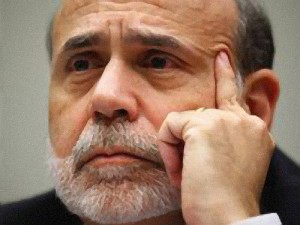Interpreting the Fed: How Did it Lower Rates This Time?
 Photo: snowlepard
Photo: snowlepardI’ve found a lot of the recent discussion about the Fed to be, frankly, confused. So I thought it worth trying to put the issues into a broader context.
Read the Fed’s latest statement, and you’ll see many of the themes I’ve talked about recently. They’ve learned that the economy is not only weak, but that—as I’ve been forecasting for some time—“economic growth so far this year has been considerably slower than the Committee had expected.” Turn to the labor market, and they somewhat dryly note “a deterioration in overall labor market conditions.” And while they won’t use the word double dip, they do note that “downside risks to the economic outlook have increased.” Also, “inflation has moderated.” So there’s plenty of room for them to try to goose the economy. But how?
Typically, the Fed does this by reducing the Federal Funds Rate, which is an interest rate on overnight loans. Unfortunately, that short-term interest rate is now pretty much at zero, and can’t go any lower. The thing is, no-one actually cares about the Fed Funds Rate. You and I and the businesses we work for don’t borrow using short-term interest rates. Instead, we finance our investments with longer-term loans. The Fed Funds Rate only matters to the extent that it reduces long-term interest rates.
So the key is for the Fed to reduce long-term rates.
Recently, the Fed has been doing this by “Quantitative Easing.” It’s a terrible name for a simple solution. Just as the Fed adjusts short-term interest rates by buying and selling overnight government securities, it can adjust long-term interest rates by buying and selling long-term government securities. That’s what QE2 did.
Many market commentators are disappointed that the Fed didn’t announce “QE3”—a renewed round of quantitative easing. But they shouldn’t be. The Fed still chose to reduce long-term interest rates, they just decided to do it with a different tool. They figured that if you can’t reduce short-term interest rates further, you should reduce ‘em for longer. That’s what the Fed was promising, when they said they expect to keep their short-term rate at “exceptionally low levels for the federal funds rate at least through mid-2013.” What does this do? Keeping short-term interest rates lower for longer will also reduce long-term interest rates. And that’s the main game. It has already worked—perhaps even more reliably than following QE2. The interest rate on two-year bonds is down to virtually zero, and the 10-year interest rate is down to 2.2 percent.
So yes, we got lower long-term interest rates. That’s what matters. And it doesn’t really matter how we got there.
If there’s anything to debate, it’s whether the Fed has done enough to stimulate investment. My bet is that they haven’t, but I think yesterday’s announcement was a useful down payment.

Comments